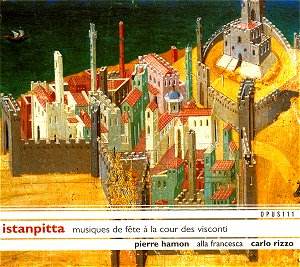Very few instrumental
pieces from the Middle Ages have come
down to us. Apart from the likelihood
that some compositions will have been
lost, there are other reasons for this
circumstance. Firstly, vocal music was
held in higher esteem than instrumental
music. The human voice was considered
the most important 'instrument', not
only in the Middle Ages, but well into
the 18th century. Hardly any musicians
were as famous as the castrati in 18th
century opera. And in the early 17th
century in Italy the violin and cornet
were especially highly valued because
of all the instruments they were best
able to imitate the human voice.
Another reason is the
fact that most instrumentalists were
improvising while playing. It is even
quite possible that a number of them
wasn't able to read music. Usually music
was handed down orally.
The music on this disc
consists mainly of two forms of instrumental
music, the 'istanpitta' and the 'saltarello'.
All pieces are of Italian origin dating
from the 14th century and come from
one manuscript, which is in the British
Library.
There is much uncertainty
about the precise function of these
pieces. If one looks in encyclopedias
and books on music history the istanpitta
and saltarello are usually referred
to as dance music. The writers all quote
the main source of knowledge about this
music, the treatise 'De musica' by the
French theorist Johannes de Grocheo,
which dates from around 1300. But in
his liner notes, Francis Biggi, doubts
this view. In regard to the istanpitta
he is even quite specific: "The Istanpitte
are chamber compositions, not intended
to be danced to." He also refers to
De Grocheo (calling the istanpitte 'stantipes'):
"he refers to the stantipes as a complex
instrumental form, made up of a varying
number of 'puncta' - that is, melodic
sections - repeated twice with different
cadences. Grocheo never refers to 'stantipes'
as dance music; he insists on their
complexity and asserts that they require
great concentration from both players
and listeners."
Specifically excluding
the possibility of the istanpitta being
dance music Francis Biggi is less certain
about the character of the saltarello
or the Lamento di Tristano, He suggests
the saltarelli "are instrumental pieces,
deriving as it were from dance music,
but composed with different ends in
view."
It doesn't happen that
often that one has the opportunity to
listen to a number of pieces of this
kind in one sequence. More than any
recording I know this one impressively
displays their complexity. Their structure
is well explained in the booklet, but
even so it is very difficult to follow.
I suppose it just needs listening more
often to understand what this music
is all about. That, of course, tells
a lot about the quality of the music.
Why were these pieces
composed? There is a theory that they
have been written and played at the
occasion of the marriage of Gian Galeazzo
Visconti and Isabella of France in 1360.
But since there is no firm evidence
of this, the title of this disc is a
little too specific.
Whereas the booklet
contains a lot of information about
the music, it doesn't say anything about
the instruments used. They are all listed,
but only in French. Most of them are
not difficult to translate, but their
precise character isn't always clear.
'Tamburello' and 'tammora' are both
frame drums. The 'tambour à corde'
is a string drum, but what is the difference
with the 'tambour sur cadre'?
This recording may
give the impression of an scientific
discourse on two important forms of
medieval instrumental music. But that
is not the case, on the contrary. The
performance stands out for its liveliness
and spontaneity. This is the result
of very careful preparation, aimed at
"playing together in interactive, improvisatory
fashion".
As far as I am concerned,
that certainly is paying off. While
listening I was that much carried away
by the virtuosity of the playing, the
variation and the interaction between
the players that I hardly paid any attention
to the structure of the music.
The technical command
of the instruments is impressive. I
also liked the combination of instruments.
In line with medieval preferences instruments
of different families - strings and
wind instruments - don't play together,
avoiding the multi-colouredness of less
'historically correct' interpretations.
Most pieces are preceded
by improvised 'preludes'. I don't see
the need for them, in particular since
some of them are too long, for instance
the one that precedes the Lamento di
Tristano. I also think that the addition
of a traditional Italian 'saltarello'
is a little out of place, considering
the difference in style with the other
pieces and the fact that it is the only
item which is sung.
I warmly recommend
this recording. It is a must for lovers
of medieval music, but considering the
way this repertoire is performed here
I wouldn't be surprised if it would
appeal to a much wider audience. I certainly
hope so.
Johan van Veen

